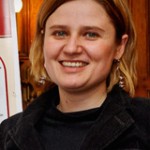 Congratulations to the
Congratulations to the
2017 Leo Hendrik Baekeland Award Winner!
Professor William Dichtel
Professor of Chemistry, Northwestern University
2017 Baekeland Symposium
Featuring Prof Dichtel as Keynote Speaker
- Date: Friday, December 8, 2017
- Time: 12:00 PM
- Place: Rutgers University Inn & Conference Center Parking in Lots 74A & 82 without permits
- Flyer
Invited Speakers
- Christopher Alabi
- Natalia Shustova
- Jeffrey Moore
- Timothy Swager
Program Agenda:
- 12:00 – Registration / Snacks
- 12:30 – Welcome Address Dr. Miriam Gulotta, Baekeland Symposium Chair
- 12:40 – Professor Christopher A. Alabi
Coupling Molecular Design to Structure and Activity of Sequence-Defined Macromolecules - 1:20 – Professor Natalia Shustova
Fulleretic Materials for Directional Energy Transfer - 2:00 – Professor Jeffrey S. Moore
Organic Chemistry at the Interface of Materials and Mechanics - 2:40 – Break / Refreshments
- 3:20 – Professor Timothy M. Swager
Dynamically-Reconfigurable Complex Emulsions - 4:00 – Baekeland Award Presentation Dr. Landon Greene, NJ-ACS Section Chair
- 4:10 – Keynote: Professor William Dichtel
Covalent Organic Frameworks as a Platform for Molecular Assembly - 4:50 – Closing remarks Dr. Les McQuire, NJ-ACS Awards Chair
Abstracts
Dr. Christopher A. Albi: Coupling Molecular Design to Structure and Activity of Sequence-Defined Macromolecules
Control over primary sequence and structure is critical to the development of new functional materials such as catalysts, synthetic affinity ligands and therapeutics, sequence responsive scaffolds, programmable biomaterials and much more. Motivated by these opportunities and the need for sequence-control and structural diversity in polymer research, we present a versatile methodology for the assembly of a new class of sequence-defined macromolecules called oligoTEAs. With sequence-control in hand, we are currently working to establish sensitive solution-phase structural characterization methods to determine their conformational dynamics and to formulate sequence-structure relationships for biological applications. We focus on applications that leverage the advantages of these novel macromolecules such as increased serum stability, precise control of backbone and pendant group sequence, and a large scope of chemically diverse monomers. Current applications under exploration in our lab include the design of cleavable linkers to quantitate intracellular cleavage kinetics, development of novel sequences and conjugates for intracellular drug delivery, and the design of membrane selective antibacterial compounds. In this talk, I will discuss the antibacterial properties of oligoTEAs in detail by examining the kinetic phenomenon behind their mechanism of action and investigations into the effect of primary sequence, composition and structure on antibacterial properties.
Dr. Natalia Shustova: Fulleretic Materials for Directional Energy Transfer
Fulleretic materials have been of a great interest since their discovery due to the unique electronic properties imposed by their ball- and bowl-shaped molecular structures. Merging these intrinsic properties of fullerene (buckyball) and corannulene (buckybowl) derivatives with the inherent properties of crystalline metal- and covalent-organic frameworks (MOFs and COFs), namely their modularity, porosity, versatility, high surface area, and structural tunability, opens a pathway to unlock a novel class of fulleretic materials for development of optoelectronic devices, electrodes, or photosensitizers. In this talk, the first examples of corannulene-based frameworks as well-defined fulleretic donor-acceptor materials will be discussed. Furthermore, in combination with photoluminescence measurements, the theoretical calculations of the spectral overlap function, Förster radius, excitation energies, and band structure were employed to elucidate the photophysical and energy transfer processes in fulleretic materials. We envision that the well-defined crystalline fulleretic donor–acceptor architectures could contribute not only to the basic science of fullerene chemistry but would also be used towards effective development of organic photovoltaics and molecular electronics.
Dr. Jeff Moore: Organic Chemistry at the Interface of Materials and Mechanics
Department of Chemistry and The Beckman Institute for Advanced Science and Technology, University of Illinois at Urbana-Champaign, Illinois, 61801 jsmoore@illinois.edu http://sulfur.scs.uiuc.edu In this talk I will discuss the molecular design of organic structural materials that mimic the ability of living systems to protect, report, heal and even regenerate themselves in response to damage, with the goal of increasing lifetime, safety and sustainability of many manufactured items. I will emphasize recent developments in frontal ring-opening metathesis polymerization (FROMP) to manufacture composites with minimal energy consumption. The talk will also present a workflow for the design, evaluation, and development of new “mechanophores”, a term that has come to mean a molecular unit that chemically responds in a selective manner to a mechanical perturbation. Mechanophores are building blocks for the development of mechanoresponsive materials with protection and sensing functions. The impact and challenges of introducing these capabilities in real-world situations will be mentioned.
References:
- Patrick, J.F.; Robb, M.J.; Sottos, N.R.; Moore, J.S.; White, S.R. Polymers with Autonomous Life-cycle Control, Nature, 2016, 540, 363-370.
- Li, J.; Nagamani, C.; Moore, J.S. Polymer Mechanochemistry: From Destructive to Productive, Chem. Res., 2015, 48, 2181-2190.
Dr. Timothy M. Swager: Dynamically-Reconfigurable Complex Emulsions This lecture will focus on the design of systems wherein the reconfiguration of immiscible fluorocarbon/hydrocarbon droplets can be triggered chemically of mechanically.[1] The utility of these methods is to generate transduction mechanisms by which chemical and biological sensors can be developed. Three different types of systems will be discussed. (1) Particles wherein a protease enzyme releases cleaves reactive surfactants.[2] (2) Janus droplets [4] that can be reoriented to give strong optical responses in response to pathogens.[5] (3) Integrated optical systems that make use of the refractory optics to create novel sensing modalities.[3]
[1] Zarzar, L. D.; Sresht, V.; Sletten, E. M.; Kalow, J. A.; Blankschtein, D.; Swager, T. M. “Dynamically Reconfigurable Complex Emulsions via Tunable Interfacial Tensions” Nature, 2015, 518, 520-524.
[2] Zarzar, L. D.; Kalow, J. A.; He. X.; Walish, J. J.; Swager, T. M. “Optical Visualization and Quantification of Enzyme Activity using Dynamic Droplet Lenses” Proc. Nat. Acad. Sci. 2017, 115, 3821-3825.
[3] Nagelberg, S.; Zarzar, L. D.; Nicholas, D.; Subramanian, K.; Kalow, K. A.; Sresht, V.; Blankschtein, D.; Barbastathis, G. Kreysing, M.; Swager, T. M.; Kolle, M. “Reconfigurable and Responsive Droplet-based Compound Micro-Lenses” Nature Comm. 2017, 8, 14673.
[4] He, Y.; Savagatrup, S.; Zarzar, L. D.; Swager, T. M. “Interfacial Polymerization on Dynamic Complex Colloids: Creating Stabilized Janus Droplets” ACS Appl. Mater. Interfaces, 2017, 9, 7804–7811.
[5] Zhang, Q.; Savagatrup, S.; Kaplonek, P.; Seeberger, P. H.; Swager, T. M. “Janus Emulsions for the Dectection of Bacteria” ACS Central Science 2017, 3, 309-313.
Dr. William Dichte: Covalent Organic Frameworks as a Platform for Molecular Assembly
Covalent organic frameworks (COFs) are two or three-dimensional polymer networks with designed topology and chemical functionality, permanent porosity, and high surface areas. These features are potentially useful for a broad range of applications, including catalysis, optoelectronics, and energy storage devices. But current COF syntheses offer poor control over the material’s morphology and final form, generally providing insoluble and unprocessable microcrystalline powder aggregates. Homogenous polymerization conditions for boronate ester-linked, 2D COFs that provide stable colloidal nanoparticles will be described. These colloids can be grown into larger, single-crystalline particles through careful control of the reaction conditions. This structural control provides new opportunities for understanding COF formation and designing morphologies for device applications. Mechanistic studies of imine-linked 2D COFs will also be discussed. These studies have revealed new catalysts that are amenable to interfacial polymerizations and the formation of extremely thin films.4
 Congratulations to the
Congratulations to the



